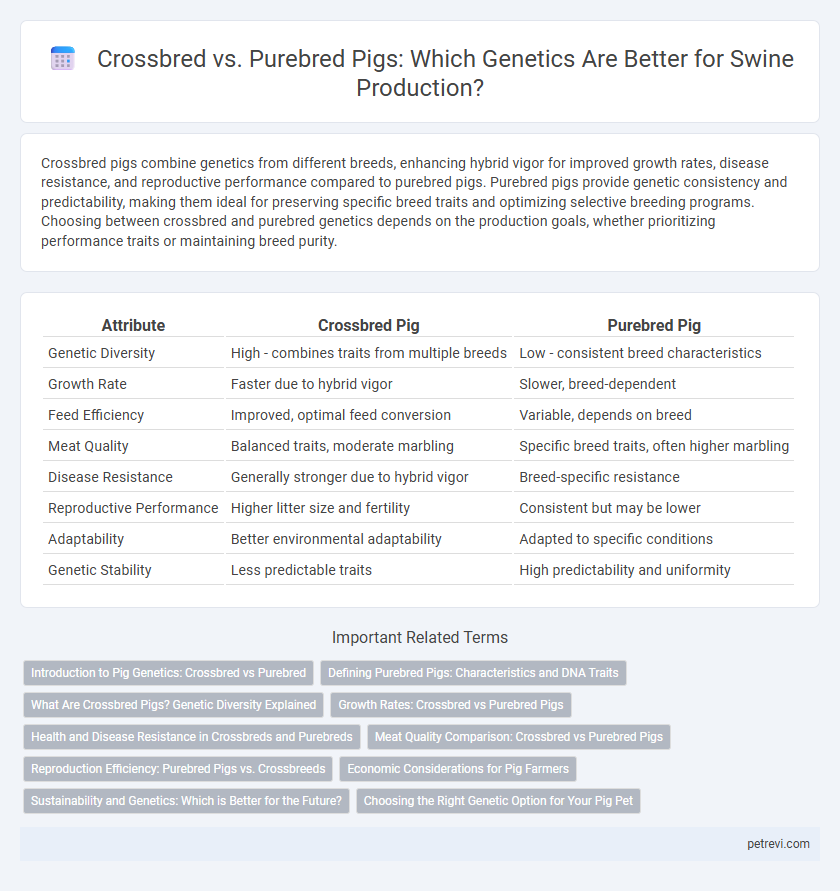Crossbred pigs combine genetics from different breeds, enhancing hybrid vigor for improved growth rates, disease resistance, and reproductive performance compared to purebred pigs. Purebred pigs provide genetic consistency and predictability, making them ideal for preserving specific breed traits and optimizing selective breeding programs. Choosing between crossbred and purebred genetics depends on the production goals, whether prioritizing performance traits or maintaining breed purity.
Table of Comparison
| Attribute | Crossbred Pig | Purebred Pig |
|---|---|---|
| Genetic Diversity | High - combines traits from multiple breeds | Low - consistent breed characteristics |
| Growth Rate | Faster due to hybrid vigor | Slower, breed-dependent |
| Feed Efficiency | Improved, optimal feed conversion | Variable, depends on breed |
| Meat Quality | Balanced traits, moderate marbling | Specific breed traits, often higher marbling |
| Disease Resistance | Generally stronger due to hybrid vigor | Breed-specific resistance |
| Reproductive Performance | Higher litter size and fertility | Consistent but may be lower |
| Adaptability | Better environmental adaptability | Adapted to specific conditions |
| Genetic Stability | Less predictable traits | High predictability and uniformity |
Introduction to Pig Genetics: Crossbred vs Purebred
Crossbred pigs combine genetics from two or more purebred lines, enhancing traits such as growth rate, fertility, and disease resistance through heterosis or hybrid vigor. Purebred pigs originate from a single genetic line, maintaining breed-specific characteristics that ensure consistency in traits like carcass quality and behavior. Understanding the genetic advantages and limitations of crossbred versus purebred pigs is essential for optimizing breeding strategies and improving production efficiency in swine farming.
Defining Purebred Pigs: Characteristics and DNA Traits
Purebred pigs exhibit uniformity in physical traits and breed standards, with well-documented pedigrees ensuring genetic consistency. Their DNA markers are closely monitored to maintain breed-specific characteristics, such as coat color, body conformation, and reproductive traits. These genetic traits contribute to predictable performance in growth rates, feed efficiency, and meat quality.
What Are Crossbred Pigs? Genetic Diversity Explained
Crossbred pigs result from mating two or more different pig breeds, combining diverse genetic traits to enhance performance characteristics such as growth rate, fertility, and disease resistance. Genetic diversity in crossbred pigs increases heterosis or hybrid vigor, improving overall productivity compared to purebred pigs, which have limited genetic variation within a single breed. This strategic breeding approach maximizes beneficial alleles from multiple breeds, optimizing traits for commercial pig production.
Growth Rates: Crossbred vs Purebred Pigs
Crossbred pigs generally exhibit faster growth rates compared to purebred pigs due to hybrid vigor, resulting in improved feed efficiency and weight gain. Purebred pigs often have more consistent genetic traits but may grow slower and require more time to reach market weight. Optimizing pig genetics through crossbreeding enhances growth performance, boosting overall production efficiency in commercial pig farming.
Health and Disease Resistance in Crossbreds and Purebreds
Crossbred pigs exhibit enhanced health and disease resistance due to heterosis, which typically improves immune response and reduces susceptibility to common swine diseases compared to purebreds. Purebred pigs, despite their genetic uniformity and predictability in traits, often face higher risks of inherited health issues and lower resilience against pathogens. Integrating diverse genetic lines through crossbreeding strengthens overall pig robustness and contributes to improved herd health management.
Meat Quality Comparison: Crossbred vs Purebred Pigs
Crossbred pigs often exhibit improved meat quality compared to purebred pigs due to heterosis, resulting in enhanced marbling, tenderness, and flavor. Purebred pigs, while offering consistency in genetic traits, may have less pronounced meat quality attributes and slower growth rates. Studies indicate crossbred pork generally achieves higher sensory evaluation scores and better consumer acceptance, making crossbreeding a preferred strategy in commercial pork production.
Reproduction Efficiency: Purebred Pigs vs. Crossbreeds
Crossbred pigs typically exhibit higher reproductive efficiency compared to purebred pigs due to hybrid vigor, resulting in increased litter size, improved piglet survival rates, and enhanced maternal traits. Purebred pigs offer genetic consistency and predictable traits but may suffer from inbreeding depression, which can reduce fertility and overall reproductive performance. Optimizing pig genetics by integrating crossbreeding strategies can enhance reproductive outcomes and farm profitability while maintaining desirable breed characteristics.
Economic Considerations for Pig Farmers
Crossbred pigs often exhibit hybrid vigor, resulting in improved growth rates, feed efficiency, and overall productivity, which can enhance economic returns for pig farmers. Purebred pigs provide consistent genetic traits essential for breeding programs but may incur higher costs due to slower growth and increased feed requirements. Evaluating market demand, production goals, and input costs helps farmers determine the most economically viable choice between crossbred and purebred pig genetics.
Sustainability and Genetics: Which is Better for the Future?
Crossbred pigs often exhibit hybrid vigor, leading to improved growth rates, disease resistance, and overall adaptability, which enhances sustainability by reducing resource inputs and mortality rates. Purebred pigs preserve specific genetic traits crucial for long-term breed conservation and genetic diversity, supporting resilience in changing environmental conditions. Balancing crossbred efficiency and purebred genetic integrity is essential for sustainable pig production and future-proofing the industry.
Choosing the Right Genetic Option for Your Pig Pet
Crossbred pigs offer enhanced hybrid vigor, resulting in improved growth rates, disease resistance, and overall hardiness compared to purebred pigs. Purebred pigs provide specific breed traits and predictable characteristics essential for showing or breeding purposes, ensuring uniformity in appearance and behavior. Selecting the right genetic option depends on your priorities for health, temperament, and purpose, with crossbreds favored for resilience and purebreds chosen for breed purity and consistency.
Crossbred vs Purebred for Pig Genetics Infographic

 petrevi.com
petrevi.com